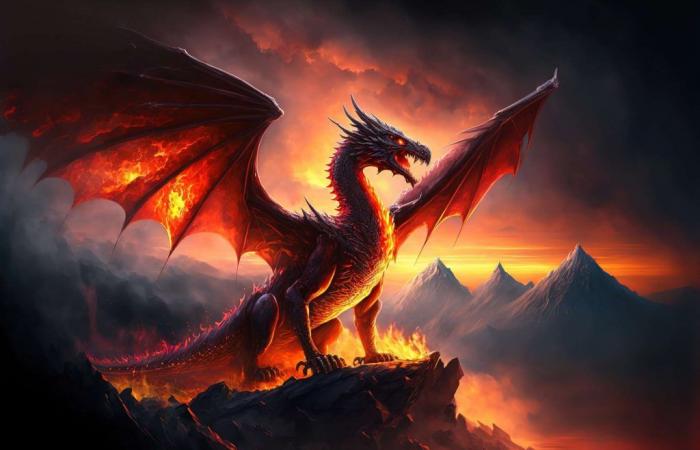In the fantasy land of Westeros, imagined by George RR Martin and brought to the screen in Game of Thrones et House of the Dragon, the spectacle of fire-breathing dragons captivates the public with a clever mix of myth and fantasy. For me at least, I also see it as a scientific curiosity.
Game of Thrones: Who is most likely to die according to science?
Images of dragons unleashing torrentstorrents of flames in the news saisonsaison of House of the Dragon got me thinking: If dragons existed, what biological mechanisms and chemical reactions might they use in the real world?
But first, a chemistry refresher. To light and maintain a flame, we need three components: a fuel, a oxidizing agentoxidizing agent also called oxidant – generally theoxygenoxygen of the’airair – and a source of heatheat to initiate and maintain the combustioncombustion.
Let’s start with fuel. Methane could be a candidate. Animals produce it when digestiondigestion. Images from Westeros show that dragons will happily eat sheep. However, our methane-powered dragons would need to have a diet and digestive system more akin to that of a cow to produce enough gazgaz to burn a city.
Storing sufficient quantities of methane is also a problem. A typical methane cylinder can be designed for a pressionpression of 150 atmospheresatmospheres, while even a swollen intestine can only tolerate a little more than one atmosphere. There is therefore no biological basis for terrestrial animals to store gases at high pressure.
“Perhaps our dragons have a vat of fermenting yeast in their insides?”
A better solution would then be a liquidliquid. Ethanol could be an option. Perhaps our dragons have a vat of yeastyeast in fermentationfermentation in their guts, or could they have a metabolic system similar to that of the poissonpoisson Cyprinodon diaboliswhich lives in the hot springs of Nevada, USA. In low oxygen conditions, these fish adopt a form of respiration that produces ethanol.
However, storage is once again an issue. Ethanol passes rapidly through biological membranes, and keeping it at high concentrations and ready for deployment at the signal “dracarys” (which translates to “dragon fire” in the fictional language of High Valyrian) would require biology of a other world.
So if we stick to explanations that have at least one foot in real-world biology, my preferred option is something more oil-like. As anyone who has accidentally set fire to a frying pan knows, it can cause fearsome flames. There is a biological basis for this in fulmars.
These birds from the polar regions produce a stomach oil rich in energyenergy which they regurgitate to feed their chicks. This oil also has a deterrent effect. When threatened, the fulmar vomits this sticky, foul-smelling oil onto its predators. Fortunately, these birds have not yet found a way to ignite their oil.
Fuel the flames
Now that we have a fuel source, let’s look at the oxidizer. As with most fires, this will likely be oxygen. However, it will take more than the oxygen in the surrounding air to generate a jet of pressurized burning oil hot enough to melt a throne of ferfer. Oxygen must be well mixed with the fuel. The more oxygen there is, the hotter the flame.
A dragon could be inspired by the chemistry used by bombardier beetles. This INSECTINSECT has developed tanks suitable for storing hydrogen peroxidehydrogen peroxide (the product used to bleach hair)). When threatened, the beetlebeetle pushes the hydrogen peroxide into a vestibulevestibule containing enzymesenzymes which quickly break it down into water and oxygen.
This is a reaction exothermicexothermic, which transfers energy to the environment and, in this case, increases the temperature of the mixture to the boiling point. The reaction is so aggressive that it is sometimes used to propel rocketsrockets. The increase in pressure caused by the rapid production of oxygen and the boiling of water forces the noxious mixture out of a vent into theabdomenabdomen of the beetle and move towards its prey or predator.
If used by a dragon, this reaction has some interesting characteristics. It would create the high pressure needed to power the fuel jet, the exothermic reaction would heat the oil, making it more suitable for combustion, and most importantly, it would generate oxygen which would fuel the combustion reaction.
All the dragon needs is some sort of biological equivalent to a gasoline engine carburetor to mix the oil with oxygen and create an explosive mixture. As a bonus, the erupting mixture would probably form a fine fogfog of oil droplets, like an aerosol, which would ignite even better.
The spark
Finally, we need a spark to ignite the mixture. For this, I will suggest that dragons have evolved an electric organ similar to that found in many fish, especially electric eels.
These organs can generate brief pulses of up to 600 voltsvolts, which is enough to create a spark in the air. If these sparks form on the ducts at the back of a dragon’s mouth, they can ignite the high-pressure jet of oil and oxygen.
Although we will never see a dragon unleashing torrents of flame outside the realm of fiction, it is interesting to think about the science behind the fantasy. So the next time you see a Targaryen commanding “dracarys,” think about the biology behind that magical blaze.






